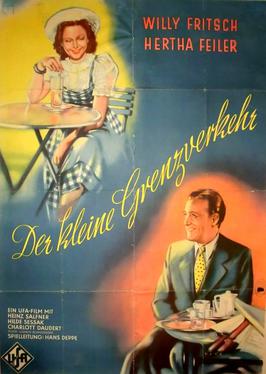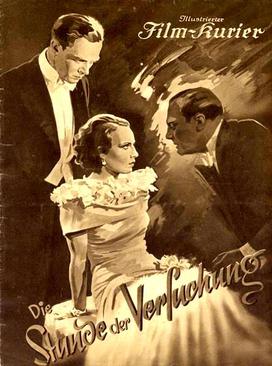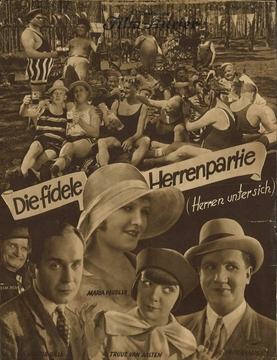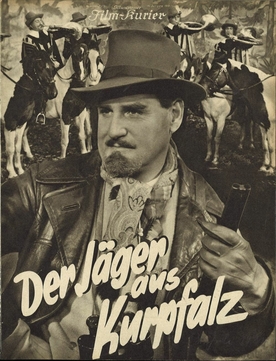
The Devil Strikes at Night is a 1957 West German crime thriller film directed by Robert Siodmak and starring Claus Holm, Mario Adorf and Hannes Messemer. The film noir is based on the true story of Bruno Lüdke. It was shot at the Baldham Studios. The film's sets were designed by the art directors Gottfried Will and Rolf Zehetbauer. Location shooting took place in Berlin and Munich. It was nominated for the Academy Award for Best Foreign Language Film, as well as winning German Film Award for Best Fiction Film in its native country.

Boccaccio is a 1936 German historical musical film directed by Herbert Maisch and starring Albrecht Schoenhals, Gina Falckenberg, and Willy Fritsch. It was shot at the Babelsberg Studios in Berlin. The film's sets were designed by the art director Otto Hunte.
Harvest is a 1936 Austrian romance film directed by Géza von Bolváry and starring Paula Wessely, Attila Hörbiger, and Artúr Somlay. It is also known by the alternative title Die Julika.

Anna Favetti is a 1938 German romantic drama film directed by Erich Waschneck and starring Brigitte Horney, Mathias Wieman and Gina Falckenberg. The screenplay was written by Walter von Hollander, adapted from his own novel Licht im dunklen Haus. The film was made at the Babelsberg Studios in Potsdam. Location filming took place in Italy and Switzerland. Its sets were designed by the art director Gustav A. Knauer.
The Schorrsiegel Affair is a 1928 German silent film directed by Jaap Speyer that featured Bernhard Goetzke, Walter Rilla and Anita Dorris. It was adapted from a novel of the same title by Fred Andreas. It was shot at the Terra Studios in Berlin. The film's art direction was by Hans Jacoby.

Adventure in Warsaw is a 1938 German-Polish comedy film directed by Carl Boese and starring Georg Alexander, Paul Klinger and Jadwiga Kenda. The film was the second of two German-Polish co-productions following Augustus the Strong (1936).

The Impossible Woman is a 1936 German romance film directed by Johannes Meyer and starring Dorothea Wieck, Gustav Fröhlich and Gina Falckenberg. It was shot at the Johannisthal Studios in Berlin and partly on location in Romania. It was based on the novel Madame will nicht heiraten by Mia Fellmann.
Gina Falckenberg was a German stage and film actress. She appeared in 22 films during her career, including Anime in tumult (1942). Falckenberg was also a writer and worked on several screenplays. She was married to the Italian actor Giulio del Torre.

A Salzburg Comedy or Little Border Traffic is a 1943 German comedy film directed by Hans Deppe and starring Willy Fritsch, Hertha Feiler and Heinz Salfner. Erich Kästner wrote the screenplay based on one of his own novels. As he had been blacklisted by the Nazi Party, he used the pseudonym Berhold Bürger. The novel was again adapted for the 1957 film Salzburg Stories.

The Hour of Temptation is a 1936 German mystery film directed by Paul Wegener and starring Gustav Fröhlich, Lída Baarová and Harald Paulsen.

Sergeant Schwenke is a 1935 German crime drama film directed by Carl Froelich and starring Gustav Fröhlich, Marianne Hoppe and Karl Dannemann. It was made at the former National Studios in Berlin's Tempelhof area which were now controlled by Froelich. The film's sets were designed by the art directors Franz Schroedter and Walter Haag. It is based on a novel of the same title by Hans Joachim Freiherr von Reizenstein. It was remade in 1955 as Sergeant Borck..

A Man with Heart is a 1932 German comedy film directed by Géza von Bolváry and starring Gustav Fröhlich, Maria Matray, and Gustav Waldau. It was shot at the Emelka Studios in Munich. The film's sets were designed by the art directors Ludwig Reiber and Willy Reiber. It was remade as the 1935 Swedish film Under False Flag. The film is based on the play A milliomos by Adorján Bónyi.

Good Fortune in Ohio is a 1950 West German comedy film directed by Heinz Paul and starring Hermann Brix, Edith Prager and Loni Heuser.
The World Wants To Be Deceived is a 1926 German silent film directed by Peter Paul Felner and starring Harry Liedtke, Georg Alexander and Mady Christians.

Gentlemen Among Themselves is a 1929 German silent comedy film directed by Rudolf Walther-Fein and starring Hermann Picha, Lydia Potechina and Maria Paudler. It was shot at the Staaken Studios in Berlin. The film's sets were designed by Botho Hoefer and Hans Minzloff.

Don't Play with Love is a 1949 West German comedy film directed by Hans Deppe and starring Lil Dagover, Albrecht Schoenhals and Bruni Löbel. It was shot at the Althoff Studios in Berlin. The film's sets were designed by the art director Willi Herrmann.
Love's Awakening is a 1936 German drama film directed by Herbert Maisch and starring Eugen Klöpfer, Karin Hardt and Hans Schlenck. It was shot at the Marienfelde Studios of Terra Film in Berlin.

Different Morals is a 1931 German comedy film directed by Gerhard Lamprecht and starring Walter Rilla, Aribert Wäscher, and Elga Brink. It was shot at the Tempelhof and Staaken Studios in Berlin. The film's sets were designed by the art director Otto Moldenhauer.

Woman Without a Past is a 1939 German drama film directed by Nunzio Malasomma and starring Sybille Schmitz, Albrecht Schoenhals, and Maria von Tasnady. It was shot at the Grunewald and Johannisthal Studios in Berlin. The film's sets were designed by the art director Hans Ledersteger.

The Hunter from Kurpfalz is a 1933 German comedy film directed by Carl Behr and starring Hans Adalbert Schlettow, Walter Rilla and Fritz Kampers. It was produced by Carl Froelich and shot at the Johannisthal Studios of Tobis Film in Berlin. Location shooting took place around Neustadt in the Palatinate and the wider Rhineland area. The title references the German folk song "Ein Jäger aus Kurpfalz".















